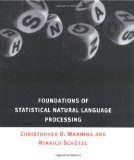カイ二乗値で単語間の関連の強さを調べる
2007-09-19-1
[Algorithm][Programming]
カイ2乗値を使って単語間の関連度を調べる方法。
つまり、関連語を探すときに、χ二乗値を関連度として使う。
perl によるサンプルコード (chiword.pl)。昔、勉強がてら作ったコード。
χ二乗値は下記の式で計算する。

添え字つきの O (オー) はプログラム中では $o11, $o12, $o21, $o22。
例えば、単語 cow と vache について考える。
対象のデータに対して、
それぞれが単体で現れる頻度、共起する頻度、どちらも表れない頻度を
カウントしたのが下記の表。
cow と vache が同時に現れるドキュメントの数 ($o11) は 56。
cow は現れるが vache は含まれていないドキュメントの数 ($o21) は 8。
その逆のドキュメントの数 ($o12) は 6。
どちらも含まれていないドキュメントの数 ($o22) は 57930。
この4つの値でχ二乗値が計算できるというわけ。
以上、式の説明は、
"Foundations of Statistical Natural Language Processing" より。
さて、下記のサンプルデータ (chiword-samp.txt) でプログラムを実行。
1行1ドキュメント。フォーマットは CSV。
各行には、同じドキュメントに現れた単語が含まれている。
ドキュメントに現れた単語がカンマ区切りで並んでいると考えれば良い。
これを chiword.pl にかけると、つながりの強い順に単語ペアが出力される。
参考:
■Christopher D. Manning and Hinrich Schutze, Foundations of Statistical Natural Language Processing, MIT Press. Cambridge, MA: May 1999.
 [2006-04-11-2]
[2006-04-11-2]
相互情報量を使う場合はこちらを参考に。
- [を] Blog Hackers Conference 2005[2005-05-27-1]
手軽にシンプソン係数[2006-03-08-2]でもよいかも。
追記070920: 数式まわりの解説を追加した。
追記140109: プログラムに間違いがあったため全面改訂。出力結果を head してたのをやめて全部出した。
つまり、関連語を探すときに、χ二乗値を関連度として使う。
perl によるサンプルコード (chiword.pl)。昔、勉強がてら作ったコード。
#!/usr/bin/perl
use strict;
use warnings;
my %cnt;
my $pair_num;
while (<>) {
chomp;
next if /^\s*$/;
my @list = sort split(/,/, $_);
for (my $i = 0; $i < @list; $i++) {
for (my $j = $i + 1; $j < @list; $j++) {
next if $list[$i] eq $list[$j];
$cnt{word}{$list[$i]}++;
$cnt{word}{$list[$j]}++;
$cnt{pair}{join("\t", sort $list[$i], $list[$j])}++;
$pair_num++;
}
}
}
my %chi_square_value;
foreach my $p (keys %{$cnt{pair}}) {
my ($w1, $w2) = split(/\t/, $p);
my $o11 = $cnt{pair}{$p};
my $o12 = $cnt{word}{$w2} - $o11;
my $o21 = $cnt{word}{$w1} - $o11;
my $o22 = $pair_num - $cnt{word}{$w1} - $cnt{word}{$w2} + $o11;
my $n = $pair_num;
$chi_square_value{$p} = ($n * ($o11*$o22 - $o12*$o21)**2) /
(($o11+$o12)*($o11+$o21)*($o12+$o22)*($o21+$o22));
}
foreach (sort {$chi_square_value{$b} <=> $chi_square_value{$a}}
keys %chi_square_value) {
print "$chi_square_value{$_}\t$_\n";
}
χ二乗値は下記の式で計算する。

添え字つきの O (オー) はプログラム中では $o11, $o12, $o21, $o22。
例えば、単語 cow と vache について考える。
対象のデータに対して、
それぞれが単体で現れる頻度、共起する頻度、どちらも表れない頻度を
カウントしたのが下記の表。
| cow | !cow | |
| vache | 59 | 6 |
| !vache | 8 | 570934 |
cow と vache が同時に現れるドキュメントの数 ($o11) は 56。
cow は現れるが vache は含まれていないドキュメントの数 ($o21) は 8。
その逆のドキュメントの数 ($o12) は 6。
どちらも含まれていないドキュメントの数 ($o22) は 57930。
この4つの値でχ二乗値が計算できるというわけ。
以上、式の説明は、
"Foundations of Statistical Natural Language Processing" より。
さて、下記のサンプルデータ (chiword-samp.txt) でプログラムを実行。
1行1ドキュメント。フォーマットは CSV。
各行には、同じドキュメントに現れた単語が含まれている。
ドキュメントに現れた単語がカンマ区切りで並んでいると考えれば良い。
hello,this,is,a,pen i,love,a,pen i,have,the,pen,with,love the,cat,with,love this,pen,is,hello this,pen,is,mine a,pen,is,love
これを chiword.pl にかけると、つながりの強い順に単語ペアが出力される。
% ./chiword.pl chiword-samp.txt 2.83051588365177 is love 2.61597458132189 pen the 2.61597458132189 pen with 2.23322255731561 love pen 0.901101336606656 cat with 0.901101336606656 cat the 0.823194884563151 the with 0.7703081232493 have pen 0.689179927290065 i pen 0.582010582010582 hello this 0.55 a this 0.489672364672365 mine this 0.396299545459209 is pen 0.346638655462185 a pen 0.346638655462185 pen this 0.313854708550087 hello pen 0.274216524216524 is this 0.203161938534279 a i 0.191637630662021 a love 0.165304780689396 is mine 0.131648936170213 have i 0.131648936170213 have the 0.131648936170213 have with 0.108227585906157 hello is 0.103803716608595 cat love 0.0895400895400895 a is 0.0862369337979094 have love 0.0818452380952381 a hello 0.031602384543561 mine pen 0.0315117134449977 i the 0.0315117134449977 i with 0.00101934909926607 love the 0.00101934909926607 i love 0.00101934909926607 love with
参考:
■Christopher D. Manning and Hinrich Schutze, Foundations of Statistical Natural Language Processing, MIT Press. Cambridge, MA: May 1999.
 [2006-04-11-2]
[2006-04-11-2]相互情報量を使う場合はこちらを参考に。
- [を] Blog Hackers Conference 2005[2005-05-27-1]
手軽にシンプソン係数[2006-03-08-2]でもよいかも。
追記070920: 数式まわりの解説を追加した。
追記140109: プログラムに間違いがあったため全面改訂。出力結果を head してたのをやめて全部出した。
